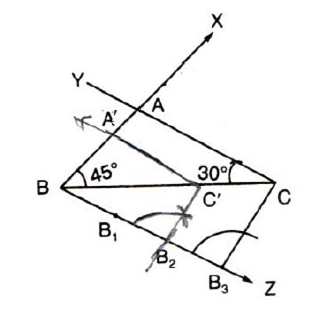 Short Answer Type
Short Answer TypeDraw a line segment of length 8 cm and divide it internally in the ratio 4: 5.
Steps of construction.
 Long Answer Type
Long Answer TypeConstruct an isosceles triangle with base 8 cm and altitude 4 cm. Construct another triangle whose sides are 2/3 times the corresponding sides of the isosceles triangle.
Draw a triangle ABC with BC = 6 cm, AB = 5 cm and ∠ABC 60. Then construct a triangle whose sides are 3/4 of the corresponding sides of the △ABC.
Construct a tangent of a circle of radius 4 cm from a point on the concentriccircle of radius 6 cm.
Draw a line segment AB of length 8 cm. Taking A as centre, draw a circle of radius 4 cm and taking B as centre, draw another circle of radius 3 cm. Construct tangents to each circle from the centre of the other circle.
Construct a triangle ABC with side BC = 7 cm, ∠B = 45°, ∠A = 105°. Then construct another triangle whose sides are 3/4 times the corresponding sides of the Δ ABC.
Draw a triangle ABC with side BC = 6 cm, C = 300 and A = 1050. Then construct another triangle whose sides are times the corresponding sides of ABC.
Using angle sum propertyof triangle, we get, B = 450.
The steps of constructions are as follows:
1. Draw a line segment BC = 6 cm.
2. At B, draw a ray making an angle of 450 with BC.
3. At C, draw a ray making an angle of 300 with BC. Let the two rays meet at point A.
4. Below BC, make an acute CBX. along BX mark off three points B1, B2, B3. Such that BB1 = B1B2 = B2B3. Join B3C.
5. From B2, draw B2C' B3C.
6. From C', draw C'A' CA, meeting BA at the point A'.
Then A'BC' is the required triangle.

